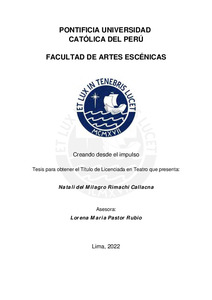| dc.contributor.advisor | Pastor Rubio, Lorena Maria | |
| dc.contributor.author | Rimachi Callacna, Natali del Milagro | |
| dc.date.accessioned | 2022-11-24T22:06:22Z | |
| dc.date.available | 2022-11-24T22:06:22Z | |
| dc.date.created | 2022 | |
| dc.date.issued | 2022-11-24 | |
| dc.identifier.uri | http://hdl.handle.net/20.500.12404/23846 | |
| dc.description.abstract | En cualquier contexto y realidad sociocultural, resulta fundamental implementar espacios
artísticos en que los niños puedan explorar, y reconocer sus ideas y sentires. Por otro lado, la
coyuntura de la pandemia ha incrementado esta necesidad y ha creado una nueva: contar con
espacios de vínculo entre los niños. Es así como el objetivo central de esta tesis es analizar el
proceso de una creación escénica con niños de 9 a 11 años del C. E. P. Sor Ana de los
Ángeles – Lambayeque, a partir de los impulsos corporal y vocal, por medio de la
implementación de un taller. A través de este proyecto, ofrecí espacios de exploración y la
introducción a nuevas maneras de experimentar las artes escénicas. Este taller lo propongo
desde mi experiencia como actriz en formación y la información recogida de diversos
autores, entre los cuales destacan Richards (2005), Dropsy (1982) y Selfa (2012).
Mi tesis es una investigación cualitativa desde las artes escénicas. En ella, participé como
observadora-participante y guía del proceso. Como resultado de este estudio, encontré que es
el cuerpo el origen de todo impulso. Asimismo, observé que las niñas y niños acudían a la
imaginación para expresar lo que sus impulsos les mandaban. Además, logré ejecutar la
improvisación sonora. También, logré vincular el pulso con el impulso, en el desarrollo de
algunas actividades en las que los participantes debían escuchar el ritmo (pulso) que se les
marcaba y, en base a eso, accionar. Esto generaba que se sorprendieran de las nuevas formas
de movimiento que podían identificar en sí mismos. Finalmente, concluí que los niños han
podido explorar un terreno novedoso; que el espacio geográfico fue muy relevante para su
desenvolvimiento en el proceso de creación escénica, puesto que se trata de un grupo de niñas
y niños con poca exposición a actividades y experiencias artísticas, y que el trabajo desde el
impulso creativo permite reaccionar de manera instintiva y natural, sin utilizar la lógica. | es_ES |
| dc.description.abstract | In any context and socio-cultural reality, it is essential to implement artistic spaces where
children can explore and recognize their ideas and feelings. On the other hand, the pandemic
situation has increased this need and created a new one: to have spaces for bonding among
children. Thus, the main objective of this thesis is to analyze the process of a scenic creation
with children from 9 to 11 years old from the C. E. P. Sor Ana de los Ángeles - Lambayeque,
from the sound, rhythmic and corporal impulses, through the implementation of a workshop.
Through this project, I offered spaces for exploration and the introduction to new ways of
experiencing the performing arts. I propose this workshop from my experience as an actress
in training and the information gathered from various authors, among which Richards (2005),
Dropsy (1982) and Selfa (2012) stand out.
My thesis is a qualitative research from the performing arts. In it, I participated as an
observer-participant and guide of the process. As a result of this study, I found that the body
is the origin of all impulse. Likewise, I observed that the children used their imagination to
express what their impulses sent them. In addition, I was able to perform sound
improvisation. I was also able to link the pulse with the impulse, in the development of some
activities in which the participants had to listen to the rhythm (pulse) that was marked for
them and, based on that, act. This generated that they were surprised by the new forms of
movement that they could identify in themselves. Finally, I concluded that the children have
been able to explore a new terrain; that the geographical space was very relevant for their
development in the process of scenic creation, since this is a group of children with little
exposure to artistic activities and experiences, and that working from the creative impulse
allows them to react instinctively and naturally, without using logic. | es_ES |
| dc.language.iso | spa | es_ES |
| dc.publisher | Pontificia Universidad Católica del Perú | es_ES |
| dc.rights | info:eu-repo/semantics/openAccess | es_ES |
| dc.rights.uri | http://creativecommons.org/licenses/by/2.5/pe/ | * |
| dc.subject | Teatro escolar e infantil--Perú--Lambayeque | es_ES |
| dc.subject | Teatro escolar e infantil--Estudio y enseñanza | es_ES |
| dc.subject | Artes escénicas | es_ES |
| dc.title | Creando desde el impulso | es_ES |
| dc.type | info:eu-repo/semantics/bachelorThesis | es_ES |
| thesis.degree.name | Licenciado en Teatro | es_ES |
| thesis.degree.level | Título Profesional | es_ES |
| thesis.degree.grantor | Pontificia Universidad Católica del Perú. Facultad de Artes Escénicas | es_ES |
| thesis.degree.discipline | Teatro | es_ES |
| renati.advisor.dni | 40116342 | |
| renati.advisor.orcid | https://orcid.org/0000-0003-2560-3724 | es_ES |
| renati.author.dni | 46175870 | |
| renati.discipline | 215586 | es_ES |
| renati.juror | Villanueva Bustios, Jorge Luis | es_ES |
| renati.juror | Pastor Rubio, Lorena Maria | es_ES |
| renati.juror | Valencia Piñan, Katiuska Elvira | es_ES |
| renati.level | https://purl.org/pe-repo/renati/level#tituloProfesional | es_ES |
| renati.type | https://purl.org/pe-repo/renati/type#tesis | es_ES |
| dc.publisher.country | PE | es_ES |
| dc.subject.ocde | https://purl.org/pe-repo/ocde/ford#6.04.04 | es_ES |






